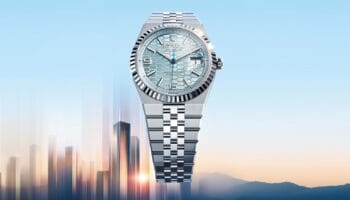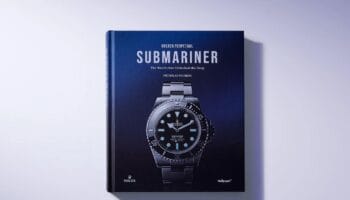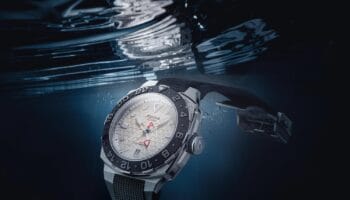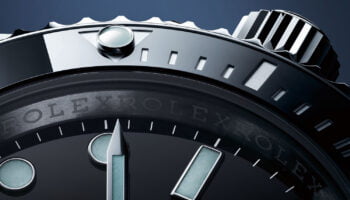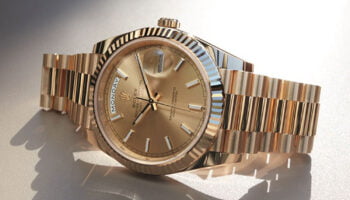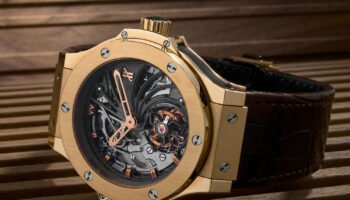With the introduction of the Heritage Black Bay in 2012 Tudor hit the bull’s-eye. In one fell swoop the sister brand of the mighty Rolex stopped being a producer of wallflowers and instead became the manufacturer of a desirable diver’s watch that captured all eyes. All the commotion surrounding Tudor drew away attention from the stoically operating Rolex. Has Tudor become cooler than Rolex?
For a long time Rolex and Tudor did not deviate a centimetre from their plotted course. Rolex produced watches that were above reproach and Tudor put out a stream of more or less anonymous products at a fraction of the price of a Rolex. It has been said that the shield protects the crown when talking about the positioning of Tudor and Rolex, but for a long time the shield was looking so poorly that the crown was more or less on its own.
Mathematical formula

With, firstly, the introduction of the Heritage Chrono ‘Monte Carlo’ – a retro-chronograph – in 2010, followed by the popular Black Bay, Tudor suddenly found itself in the spotlight. The Black Bay is a direct descendant of the Tudor Submariners that date back to 1954. In an era where the nostalgia of the global watch lover knows no bounds, the Black Bay models are king. Vintage Rolex Subs have become prohibitive for many, and that gap is being filled by the retro diver’s watches of Tudor. The collection has now grown and been enhanced. The steel variants are available with a red, blue and black bezel, there is a completely black variant, a large bronze version and a smaller 36mm version, and various historically correct and at the same time trendy straps are also available. The Black Bay collection is like a complex but watertight mathematical formula; everything is just right, including the attainable price level of just under 3,000 euro. The Black Bay is based on a Tudor Oyster Prince Submariner reference 7992 from 1954, but also on ‘Snowflake’ Submariners from 50 years ago and the ‘Big Crown’ reference 7924. Contrary to Rolex, Tudor freely experimented with colours and hand shapes. There are experiments with Rolex colours, but these are conducted by Bamford, Titan Black or Project X, for example; small companies that customise exclusive watches with every possible colour combination, striking dials and coated cases and then charge a hefty price for them. The old and the new ‘Pepsi’ are watches that belong to different generations, that came into being as a result of a logical evolution and that don’t really take the wishes of the consumer into account. Rolex is like a primal force, inwardly focused to produce the best possible products.
RAF tribute

The latest version of the Milgauss with coloured sapphire crystal is an almost un-Rolexian piece of excess. The Submariner and the GMT are deadly serious but the anti-magnetic Milgauss is a more playful creation intended for a trendsetting young target group; an advance scouting party on a reconnaissance expedition. However, the Milgauss is too unique, and its name and background not sexy enough to charm and engage a large target group. The history of the Air-King, the sporty Rolex entry-level model that has been in production non-stop for 70 years, is much more exciting. When the Second World War was nearing its end Rolex founder Hans Wilsdorf decided to honour the courageous Royal Air Force pilots who had won the Battle of Britain with a series of watches with an aviation theme. The ‘Air’ series consisted of the Air-Lion, Air-Giant, Air-Tiger and of course the Air-King. Only the Air-King has stayed in the collection consistently. The first real Air-King, the 4925, was introduced in 1945. In 1958 different new variants were devised, including the Air-King-Date and the 550X models for the British Commonwealth. Incidentally, the 35mm 5504 Explorer was used for the Air-King as well. To make things even more complex there are also cases, the 5500 cases, that were used for both the Air-King and the Explorer. The last variant of the Air-King had a 34mm case which, by today’s standards and tastes, is much too small.
On-board instruments

The new Air-King 116900 has grown 6mm to a sizeable 40mm. As we’re talking about cases anyway, we can reveal that it is the same case of 904L steel as the Milgauss, including the soft iron, anti-magnetic inner case. The automatic 4 Hz chronometer calibre 3131 with 48-hour power reserve and the blue Parachrom balance spring is the same as well, but the appearance is really quite different. The dial is an ode to aviation and the style was previously seen in the two Rolex on-board instruments in the Bloodhound SSC, a Rolex-sponsored project intended to produce the fastest car in the world – this year the rocket car is expected to exceed 1,000 miles an hour, an absolute world record. Obviously the ‘Rolex green’ features prominently, in addition to a lot of functional black and white. It creates a powerful look that is intended to appeal mainly to a young, sporty target group. The price ticket of 5,700 euro, the lowest-priced sports watch in the catalogue, will certainly help.
There is something striking about the dial of the new Air-King. Those who see the shiny 3, 6 and 9 are probably reminded of the 39mm Explorer. The previous Explorer, because at the recent BaselWorld the ‘corrected’ version of this watch was presented without the shiny, Arabic numerals that were a thorn in the eye to many. These numerals are now popping up in the new Air-King. As a result the dial may be classed as very eclectic, because shiny numerals, functional military elements (go on, count the number of times you see the number ‘5’), Mercedes and lollipop hands and colour details (yellow crown, green signature and seconds hand) have been combined into a completely new appearance.
Retaining its value
The new Air-King is supposed to do what the 39mm restrained Explorer and the eccentric Milgauss don’t: appeal to a large group of young people who want to wear a highly visible Rolex and show it off to anyone who asks. A Tudor Black Bay also has a prominent appearance, but it is lacking the instant recognisability of a Rolex. You can buy two Black Bays for the price of one Air-King. Both watches are fitted with manufacture movements that use a silicon balance spring, for example, and are chronometer-accurate. For purists and other obsessive watch lovers there is perhaps more of a story to the Black Bay than to the new Air-King. We should test this theory by starting a conversation in the pub with both an Air-King and a Black Bay wearer to see who has the most to say about the time instrument on their wrist, but we suspect that the man/woman with the Tudor will have the bigger story. However, the main difference between the Air-King and the Black Bay is that 50 years from now the current Air-King will be an original classic and the Black Bay will always be a reinterpretation of a classic. And the Air-King will therefore definitely still be worth its 5,700 euro price ticket, if not more.
Black Bay 2016
As an addition to the 41mm steel models, water resistant to 200m and with a red, blue and black bezel, three new references were added to the catalogue during BaselWorld 2016: the Black Bay Dark is coated in black PVD, the bronze-coloured version is slightly larger with a 43mm case made of an aluminium-bronze alloy and finally the very different-looking 36mm variant that has to make do without a coloured bezel. The 41 and 43mm cases now house the automatic chronometer-accurate calibre MT5602 with silicone balance spring. ‘MT’ stands for ‘Movement Tudor’ and the movement with 70-hour power reserve replaces the ETA movement that was traditionally used to keep the price down. Also worth mentioning is the introduction of a redesigned steel bracelet modelled after the ‘rivet’ bracelets of the 1950s and 60s. The bronze, the black case, the bracelets; the Black Bay always provides topics for conversation.




